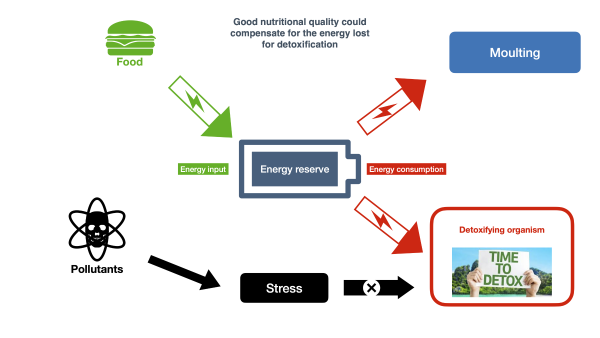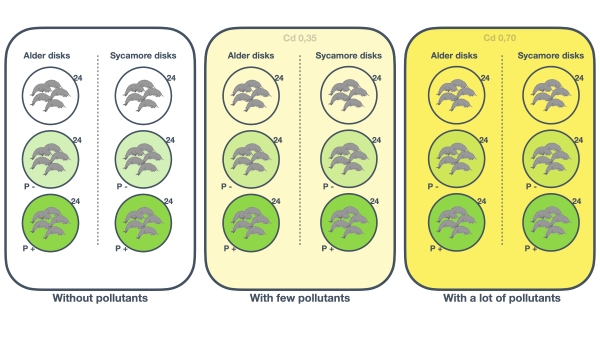Does food quality increases moult organism vulnerability to pollutant impacts? by Charlotte Couedel, Axel Rochaud and Stellia Sebihi
Published by the April 27, 2021 on 9:06 AM
Today's ecotoxicology
For a long time, ecotoxicology focused on the lethal effects of pollutants, with increased individual mortality translating into smaller population size or population extinction. There has been a shift from the study of lethal doses to the impact of smaller doses on more specific processes such as physiology and behaviour (Rand and Petrocelli, 1985; Døving, 1991). The article deals with the effect of pollutants on moulting.
Possible use of ecotoxicology (the case of the article)
Pollutants are an environmental factor causing stress in individuals. Lack of resources is another factor. For this reason, the study attempts to demonstrate and quantify the impact of food quality on the resistance to pollutants of moulting organisms.
Hypotheses of the effect of the diet on the assimilation and detoxification of pollutants
When a pollutant is assimilated by an organism, the body sets up the detoxification system, but it requires energy. Food allows the assimilation of energy by organisms. Good quality of food makes an individual capable of accumulating the energy necessary to ensure vital functions. An organism with energy from good quality food, should be able to activate an effective detoxification. Thanks to this detoxification, the body should be less impacted by pollutants. The study seeks to demonstrate whether this is true.
The interest of the biological model
Gammaridae are macro-invertebrates that are mainly detritus feeders. They feed on detritus, corpses, living or decaying plants. Moreover, they are at the base of the human food chain as they are often industrially bred as fish food. Gammaridae are used to determine the biological quality of watercourses. They are rather pollution tolerant organisms but are nevertheless affected by pollution. Could the physiological changes noticed in Gammaridae be noticed in humans?

A picture of two GammaridaeWay to understand the effects
The experiment is designed to evaluate single and combined effects of leaf litter stoichiometric quality and Cd exposure on G. fossarum survival and growth. Phosphorus (P) is used as the nutrient in leaf litter. Cadmium (Cd) is used as the pollutant. Phosphorus (P) is a nutrient naturally present in the Gammaridae's food, in this case, leaf litter. Also, industrial activities are often sources of cadmium released into aquatic environments. The main route of exposure to cadmium (Cd) is through the ingestion of contaminated water and food, so Gammaridae is particularly exposed to this type of pollutant.
144 microcosms were performed for each of the 3 levels of Cd concentrations (0 ; 0.35 ; 0.7). For each group, 72 microcosms were realised with Sycamore discs and 72 with Alder discs. It allows to observe the effect in different conditions. Then, among these 72 microcosms, three batches of 24 have been realized. The first batch is a control batch where the composition of the litter was not modified. The second batch was a P- batch, where the litter was deficient in phosphorus and therefore in nutritional value (and which does not allow individuals to extract a lot of energy). Finally, the third lot was P+, it was enriched in phosphorus, the nutritional value is very good.
Several metrics were measured to validate the initial hypotheses. The metrics were chosen for their relevance to evaluate organisms sensitivity to resources quality (leaf species and P content) and pollutant (Cd concentration in water): Cd bioaccumulation and survival rate. But also for their ecological importance: time-to-death, mass growth, time to moult and feeding rate.
Results to remember
- The Gammaridae's moult frequency and growth is amplified by a nutrient-rich diet (P+).
- A presence of pollutants (cadmium) in the Gammaridae’s life site reduces their growth and raise their probability of death.
- A nutrient-rich diet amplified effects of cadmium.
- If we make the connection: The higher quality of food ressources, the more moulting there is and the greater the effect of cadmium. So moulting makes Gammaridae vulnerable to pollutants.
- Species sensitivity to pollutants might be underestimated in ecosystems facing both nutrient constraint and pollutant.
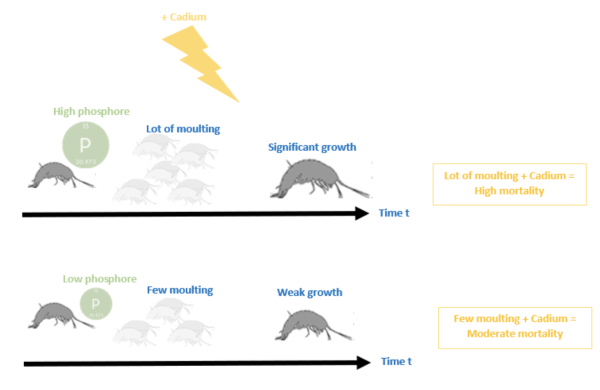
Schematization of the main resultsWhat to infer from this experiment.
The presence of pollutants in the water causes problems in the survival of Gammaridae. Ecotoxicologists are well aware of the bioaccumulation of pollutants in the food chain. As a result, a predator will be more contaminated by the pollutants than is prey. Indeed, predators will keep in them the majority of the pollutants present in their prey. Thus, humans present in the upper part of the trophic chain will be much more contaminated than the Gammare.
So why discharge pollutants into the water? Let's drink it directly!

This post is licensed under a Creative Commons Attribution-ShareAlike 4.0 International License.A new way to understand the effects of toxic compoundsby Flore Emonnot and Anne Michaud
Published by the September 7, 2020 on 8:07 AM
Water pollution is a major concern. It can be induced by many elements. For example, Cadmium (Cd) which belongs to the heavy metals family can be source of pollution in certain concentrations. This element is naturally present in the environment, but the use of agricultural chemicals has been indicated as the main anthropogenic source of Cd pollution in aquatic environments. The organisms living in these aquatic ecosystems are exposed to this pollution. Moreover, this compound is bioaccumulated in organs and tissues, so it can induce damages.
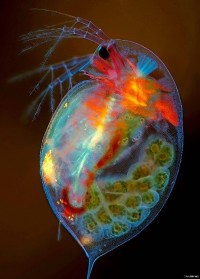
Daphnia magnaThat is why it is important to evaluate the effects of this pollutant on organisms. Daphnia magna (a cladoceran crustacean) is one of the most widely used animals in aquatic toxicology. In terms of sensitivity to toxic substances, it is generally thought to be representative of other zooplankters (Anderson, 1944). It plays an important role in the balance of an ecosystem, because of its position on the first levels of the food chain. Also, D. magna enhances water purification by filtering water and retaining food particles, it is its way to eat. This animal spends its whole life in a variety of freshwater environments. As long as the conditions remain favourable, it reproduces predominantly by parthenogenesis.
Bioassays are used in aquatic toxicology to provide individual-level information, while ecotoxicology is assessing the impact of pollution on populations. The DEB theory (Dynamic Energy Budget) is a theory that describes the aspects of metabolism (energy and mass budgets) at the individual level. Food assimilation results in energy, which can then be used for reproduction, growth or maintenance (life-history traits). The DEBtox is a toxicological application of the DEB theory which attempts to assess the effects of pollutants on life-history traits over time.
The key challenge is how to infer the impact of toxic effects observed in individuals and apply it to an entire population. Elise Billoir and her team combined the following tools to extrapolate the individual effects to the entire population:
The DEBtox is a good way of modeling survival, reproduction and growth continuously as a function of time and exposure concentration and at the individual level.
The population growth rate (which incorporates lethal and sublethal effects), is the best parameter to evaluate the risk of a pollutant on a population, hence matrix population models are a useful tool. Billoir explains that in population matrix, population is divided into classes based on development stage, and individuals transfer from a class to the next one depending on their survival and their fecundity.
By combining DEBtox theory and matrix population models, it is possible to extrapolate every effect of the toxic compound on the individual to the population level (as explained in the synthetic diagram below).
This technique used by Billoir, has not yet been used in an ecotoxicological context. It consists of reorganizing all the age-specific information in a stage-specific way. This way it makes possible to compare the sensitivity in the face of cadmium and in relation to the age of the individual.
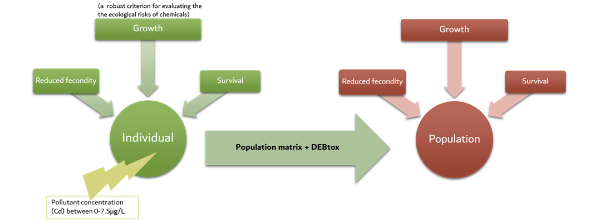
Diagram of the method developed in the study of Billoir et al.In this case, the sensitivity analyses showed that the effects of cadmium at the individual level were not significant but the application of the model proved that the population growth rate is highly affected through the cadmium contamination. Moreover, we think that this model could be applied to similar aquatic organisms and other pollutants such as heavy metals and could be useful to enhance existing bio-indicators of water quality.

This post is licensed under a Creative Commons Attribution-ShareAlike 4.0 International License.Are pesticides more dangerous when you are hungry?by Angèle Lorient
Published by the January 6, 2020 on 1:52 PM
Today, the impact of pesticides on our environment is a central issue in many publications and a major concern for all citizens. Between 2014 and 2016 the use of pesticides increased by 12%. Indeed, intensive farming currently used implies that we find in our food, in the air but also in water, traces of pesticides. A 2013 Inserm report highlights a link between exposure to pesticides and the appearance of cancer or pathology such as Parkinson's disease but also developmental problems on children. Therefore, they harm the health of humans but also the entire terrestrial and aquatic ecosystems.

Water Flea Daphnia Magna. www.aquaportail.comIn addition to using a large amount of chemicals, modern farming methods make soils less permeable. As a result, precipitation runoff is a major contributor to pesticide pollution from our streams. In order to study the toxicity of pesticides in the aquatic environment, the majority of laboratories use Daphnia as an indicator of water quality, and in particular the species Daphnia magna for their sensitivity to toxins.
Daphnies are small crustaceans measuring about 1 to 4 millimeters. They live mainly in fresh water (river, pond, lakes). They are filter feeders that help maintain the clarity of the water thanks to their ability to eat green algae. During a day they move between the bottom and the surface of the water depending on the light (photoperiod).
In 2006 a study was conducted by 4 scientists (2) to study the physiological responses (sensitivity, growth, reproduction) of daphnies to different dietary concentrations of the same pesticide to which they and their mothers were subjected. (high food or low food).
The study shows that lack of food does not play a direct role in the sensitivity of daphnies to the pesticide in question. However, it is one of the factors determining the level of absorption and elimination of this toxic substance by the body. In addition, the energy used to fight this toxin has a negative effect on the maintenance of vital functions.
In a period of low availability of food resources, invertebrates will have a more limited growth and a lower reproductive rate in proportion to the level of pesticide present in their environment. While the impact is less when they are subject to sufficient food resources (Fig 1).
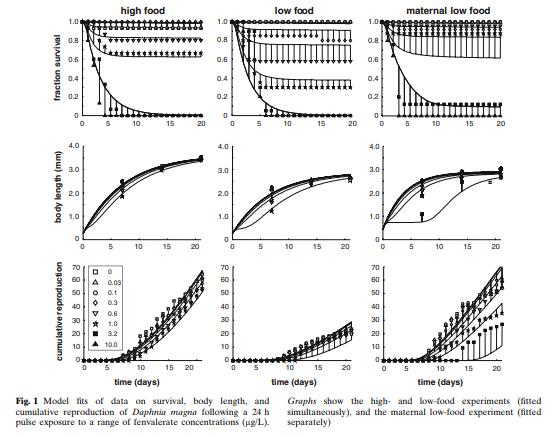
For the different types of food resource, the effect of the pesticide concentration is proportional to the survival rate. On the other hand, we can notice that there is a threshold effect concerning growth and reproduction.
However, they also highlighted that these individuals, when no longer subject to the pesticide, found a normal activity (resilience).
This study makes it possible to highlight the potential impacts on the results of the experiments if certain non-standardized conditions vary between laboratories (concentration of food, respect of the photoperiod). As well as the differences in test organism responses between conventional environmental conditions (controlled artificial environment) and the natural environment (subject to variations).
The analysis of the results of this study raises the following questions:
- What is happening in the longer term?
- Does the repeated presence of pesticide pulses have the same physiological effects on an individual throughout his life?
- Is the speed of resilience due to the species or can it vary individually?
- Is there resiliency of newborns from underfed mothers?
It also shows the urgency of taking into account the impacts of pesticides, both on our current health, on the heritage that we will transmit, but also on our ability to reproduce. Despite the mobilization of the Ministry of Agriculture including the program "Ambition bio 2017" there is urgency. Pesticides are one of the main causes of pollution in our waterways. This pollution endangers aquatic life, as has been demonstrated, but also the drinking water resource. Should not our entire consumption system be called into question in order to be able to realistically implement the planned management plans?

This post is licensed under a Creative Commons Attribution-ShareAlike 4.0 International License.Zinc pollution of our rivers: shrimp on alertby Lucille Baron and Macha Joanin
Published by the August 12, 2019 on 10:03 AM

An individual of Gammarus pulexNo, we will not make an exhaustive catalog of the pollutants that affect our streams and boredom will not settle in your heads by reading us. Instead, we have chosen to discuss the effect of one of the very present emerging pollutants zinc on Gammarus pulex, through the study of Maltby and Naylor (1990).At present, world zinc production is over 13,000 kilotons (2018). Zinc is commonly used in metal corrosion coatings and for the manufacture of fertilizers and pesticides (European Commission, 2008b). Thanks to its physico-chemical properties, zinc melts particularly in fresh water, and it is absorbed on suspended solids and sediments (INERIS, 2014). All organisms living in these ecosystems are therefore exposed to this pollution and therefore, indirectly, we too, human.
Thus, it is important to measure the risks of this exposure on organisms and especially to know the effects of zinc on populations in the long term. For this, researchers have studied, experimentally, the energy deployed in the reproductive mechanisms by aquatic organisms exposed to zinc at different concentrations. In additions, they sought to know if exposing females during a first brood (called current) could have an effect on their second brood unexposed (called subsequent).
Gammarus pulex is a sentinel species, not only because this shrimp is abundant in fresh waters of England, but in addition it is fed with particulate matter which constitutes, in the natural environment, a large zinc stock. To measure the risks of maintaining the species and the genetic heritage of each individual under the effect of zinc, it is sufficient to study the offspring of females exposed to this compound at different concentrations. The number of individuals which hatched, and the size of each one give some indication of the energy allocated to reproduction. That's what researchers at the British Ecological Society did. If you haven’t understood anything about our attempt to explain the methods used to carry out the study experience, here is a summary diagram that you may be clearer!
Diagram of the methods used for the experimentThe results they obtained are surprising and show that exposure to zinc (even at low concentrations) significantly increases the number of broods aborted. This result is related to the decline of foods assimilated by females when they are exposed to zinc. The total energy drawn from food is no longer sufficient to sustain metabolic needs while maintaining the mechanisms of maturation and reproduction. Nevertheless, when exposed females carry her brood to term, the number of offspring of each does not seem to vary, despite of the difference in duration of exposure. So, a small criticism of the Figure which represent the percentage of broods aborted in function of the concentration of zinc (Figure 3) can be realize : we found in the control situation (not exposed to zinc), a great variability between the two categories tested. So, in science when the" control "already has significant variability, the results should be interpreted with caution thus it is difficult to conclude to a difference between the current and the subsequent.
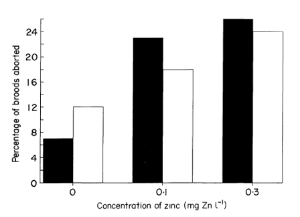
Effect of zinc on the percentage of broods aborted. Solid columns (black) represent “current” broods and open columns “subsequent” broodsThe results concerning the size variation of the descendants, bring a complementarity to this analysis because the researchers observe a reduction of the size in the generations following the exposure. It is the reduction of the available energy (females stopping feedings) which as a consequence the reduction of the size of the individuals of the next brood. Also, on this point, it is unfortunate that the study does not take into account the size of the female that could have an impact on the size of the offspring (Taïr-Abbaci K., 2016).
The increase of the number of broods aborted and the decrease of the size can have a negative impact on the fitness of populations as exposure to zinc increases abortion. Also, the smallest offspring will take longer time to mature and under stress conditions, this phenomenon may be aggravated over generations and the snowball effect may strongly decreased fitness of individuals. Ultimately, these effects can have a profound impact on the entire population.
The study seems relatively far from reality since it remains experimental, in the laboratory, and is not carried out in a natural environment and therefore with real conditions of experimentation and exposure to zinc. Thus, the adaptations set up or not by the organisms and the cocktail effects (potential combined effect of different compounds) are not taken into account.
Nevertheless, the study above begins to be old, the latter dating back to 1990.Today, techniques allow to observe the embryonic development precisely and it turns out that during the different embryonic stages aberrations can appear (Bach et al., 2010). Then, it is difficult to think that abortion is the only response implemented by females when exposed to these chemical compounds.
In addition, reproductive success does not depend solely on embryonic development. It is important to consider the energy allocated to ovocyte development and the search for sexual partners to define the impact of zinc on the Gammarus pulex cohorts.
It’s possible to reduce the production of zinc with recycling it. However, the recycling of metals can sometimes be too expensive for small industries or privates companies. So, there are other ways than the installation of water decontamination mechanisms. Thus, bio-decontamination can be considered for these companies or industry but can also be useful to large industry in addition to their mechanisms for an exhaustive decontaminations and better water quality. Agriculture is also a source of metal pollution, so it is important to carry out hedgerows planting campaigns near fresh water since they have the function of absorbing a large part of the contaminants resulting from the leaching of flooded soils.

This post is licensed under a Creative Commons Attribution-ShareAlike 4.0 International License.Time and concentration dependency in the potentially affected fraction of species: The case of hydrogen peroxide treatment of ballast waterby Marie-Adèle Dutertre and Maud Hautier
Published by the December 10, 2018 on 4:32 PM
Globalization and international trade made natural gates easier to cross for species. As a consequence, few species were able to travel long distance and settled in new habitats where they become invasive species.
More than 80% of industrialized goods in the world are transported by the oceans in container ships. In many cases, container ships is discharged in the destination port and go back empty. Whereas, the structure of this kind of ship does not allow them to travel empty and with stability. This is for a problem of stability that ballast exists. Since the 19th century, ballast with rocks was substitute with water. Before ships leave the port , water is loading in tank and at the destination port tanks are discharged.
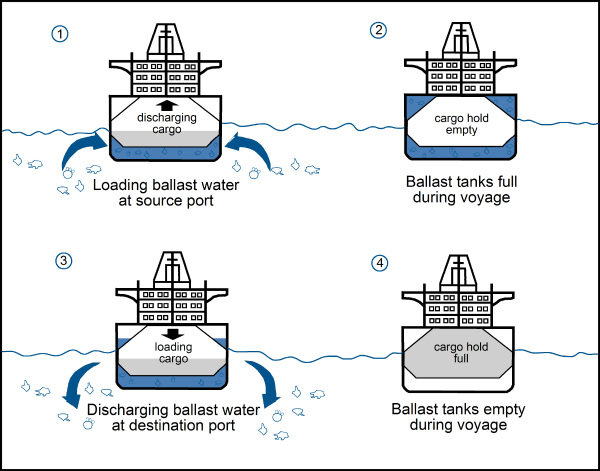
http://www.seos-project.eu/modules/marinepollution/marinepollution-c04-p05.fr.htmlBallast water transport contribute to invasive species spreading. In order to fight against exotics species, waters ballast are treated with Hydrogen Peroxide (H2O2). But there is a question : how to be sure that ballast water is effective and is not toxic for the marine environment ? In order to evaluate the environmental impact of the treatment, a study has been conducted. Three taxa has been chosen, among them, two crustacean, two algae and one rotifera : C. volutator, A. salina, E. costatum, D. teriolecta, B. plicatilis. The authors of the study consider three dimensions : Hydrogen Peroxyde concentration, the effect of the Peroxide Hydrogen on organism and Hydrogen Peroxide exposure time. In the experiment, they made the tree dimensions varied and they considered as the final aim, the mortality, the immobility and the inactivation of the organism. The results are used in a mechanistic model which is based on the description of Dynamic Energy Budget theory. The DEB theory consists of a simple set of rules that specifies how organisms acquire energy and building blocks from their environment to fuel their life cycle. It is used to rely the observed effects and the hydrogen peroxide concentration in the experiments. The DEB-tox model allows to determine ECx — Effect Concentration — : the concentration which induces a response of x% between the baseline and maximum after a specified exposure time ; and the HCx — Hazardous Concentration — : the concentration which is dangerous for x% of the population. Thanks to this values, it is possible to determine the PAF — Potentially Affected Population— with means the part of an ecosystem potentially affected by a drug concentration. The results show an interspecific response variability with means different interspecific H2O2 sensibility. Sensibility is a combination between time exposure and the concentration. The conclusion of the study is that the hydrogen peroxide is effective for treating ballast water.
Concentrations, effects and time exposure were studied there. The choice of the five species is a wise choice as a result of the representativeness of a wide selection of sensibility which allows to extrapolate this results to other species and then estimate the effect of hydrogen peroxide treatment on other species present in water ballast. Whereas the aim of the study was to assess environmental risks of hydrogen peroxide treatment, and the obtained results here cannot be used to conclude regarding as the environmental risks.
To assess more precisely the risk, it is important to consider the hydrogen peroxide degradation and its potential impact on marine ecosystem. The H2O2 is oxygenated water which would rapidly be decomposed : 2H2O2 => 2H2O + O2. In this case, the hydrogen peroxide would not impact the environment.
Furthermore, sub-lethal effects are sufficient to reduce the viability of the organisms and for that, lower concentration of H2O2 and lower time exposure are sufficient. The purpose is to neutralize exotic species with lower environmental and economic costs. Moreover, in order to reduce again the hydrogen peroxide used quantity, other studies show the efficiency of using UV, Ozone, and ultrasound for neutralizing species. The hydrogen peroxide treatment can also be used with alkaline water which allows to obtain the same result with lower concentration and time exposure.
An other option is to establish regulated areas for discharging and to filter and to purify ballast water before discharging in the environment.

This post is licensed under a Creative Commons Attribution-ShareAlike 4.0 International License.






